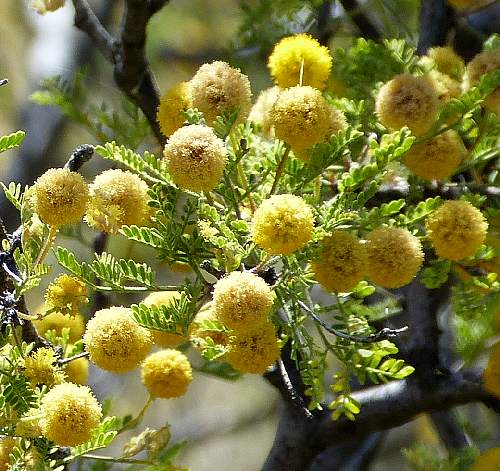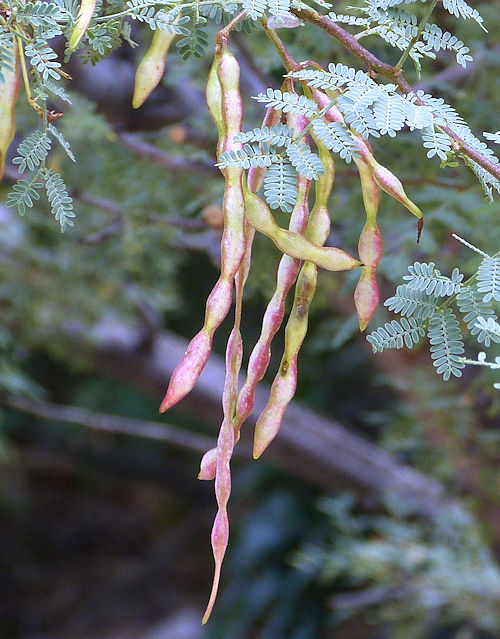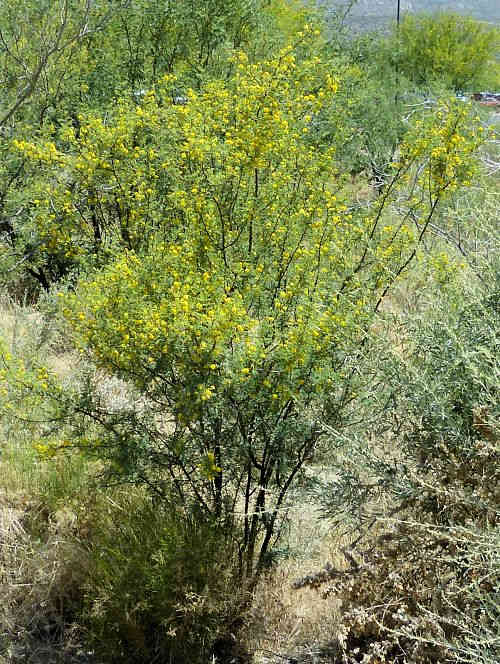Growing Vachellia constricta:
Whitethorn Acacia
Back to Trees and Palms
Description
Form: A large, multi-stemmed shrub that can be trained into a tree.
Lifespan: 70+ years.
Leaf retention: Cold-deciduous.
Growth rate: Slow to moderate depending on water.
Mature Size: 12-18' (3.7-5.5m) high and wide.
Flowers: Bright yellow, 1/2" (12mm) diameter puffballs, fragrant, without nectar.
Bloom: A first bloom occurs in spring. The second bloom appears mid to late summer with rainfall, but may not occur during a drought.
Fruit: Flattened, reddish-tan bean pods, constricted between adjoining edible beans.
Leaves: Small, green leaflets arrayed along an axis. This plant provides light filtered shade.
Stems: White thorns of varying lengths are arrayed in pairs along leaf nodes. Young plants have more thorns. Some individuals may have none. This plant has a more slender trunk compared to other related species. Nectar glands (nectaries) occur on stems bearing flower stalks, inducing ants to visit. The ants protect this plant from predatory insects that would reduce seed production.
Roots: Nitrogen-fixing*. Widespread lateral roots and a taproot.
Wildlife: The flowers attract bees and butterflies. Extrafloral nectaries attract ants. Both bees and ants are associated with high seed production. The pods and beans attract many birds, including quail, and small mammals.
Toxic / Danger: Thorns.
Origin: Arizona through Texas and Mexico. A separate, ancient population is found in Maryland and Virginia.
Form: A large, multi-stemmed shrub that can be trained into a tree.
Lifespan: 70+ years.
Leaf retention: Cold-deciduous.
Growth rate: Slow to moderate depending on water.
Mature Size: 12-18' (3.7-5.5m) high and wide.
Flowers: Bright yellow, 1/2" (12mm) diameter puffballs, fragrant, without nectar.
Bloom: A first bloom occurs in spring. The second bloom appears mid to late summer with rainfall, but may not occur during a drought.
Fruit: Flattened, reddish-tan bean pods, constricted between adjoining edible beans.
Leaves: Small, green leaflets arrayed along an axis. This plant provides light filtered shade.
Stems: White thorns of varying lengths are arrayed in pairs along leaf nodes. Young plants have more thorns. Some individuals may have none. This plant has a more slender trunk compared to other related species. Nectar glands (nectaries) occur on stems bearing flower stalks, inducing ants to visit. The ants protect this plant from predatory insects that would reduce seed production.
Roots: Nitrogen-fixing*. Widespread lateral roots and a taproot.
Wildlife: The flowers attract bees and butterflies. Extrafloral nectaries attract ants. Both bees and ants are associated with high seed production. The pods and beans attract many birds, including quail, and small mammals.
Toxic / Danger: Thorns.
Origin: Arizona through Texas and Mexico. A separate, ancient population is found in Maryland and Virginia.
Cultivation and Uses
USDA hardiness zones: 7-11.
Heat tolerant: Yes.
Drought tolerant: Yes.
Sun: Full sun.
Soil: Well draining, pH 6.6-8.5 (neutral to alkaline). *Do not use a nitrogen fertilizer.
Water once established: Deep water monthly during drought.
Prune: As needed to develop a tree form.
Litter: Low.
Propagation: Seed which as been scarified and buried in soil 1/2" (13mm) deep.
Pests: This plant can be prone to mistletoe when given insufficient water.
Uses: Ornamental, bird garden.
USDA hardiness zones: 7-11.
Heat tolerant: Yes.
Drought tolerant: Yes.
Sun: Full sun.
Soil: Well draining, pH 6.6-8.5 (neutral to alkaline). *Do not use a nitrogen fertilizer.
Water once established: Deep water monthly during drought.
Prune: As needed to develop a tree form.
Litter: Low.
Propagation: Seed which as been scarified and buried in soil 1/2" (13mm) deep.
Pests: This plant can be prone to mistletoe when given insufficient water.
Uses: Ornamental, bird garden.
Comments
Vachellia constricta is a member of the Legume family (Fabaceae). Its scientific synonym is Acacia constricta. This species differs from Vachellia farnesiana in having multiple, more slender, trunks. Its bean pods are also longer, flatter, and lighter in color, sometimes reddish.
Do you have additional information or a different experience for these plants that you would like to share? Email info@GardenOracle.com. All contributions are welcome and appreciated.
Vachellia constricta is a member of the Legume family (Fabaceae). Its scientific synonym is Acacia constricta. This species differs from Vachellia farnesiana in having multiple, more slender, trunks. Its bean pods are also longer, flatter, and lighter in color, sometimes reddish.
Do you have additional information or a different experience for these plants that you would like to share? Email info@GardenOracle.com. All contributions are welcome and appreciated.



Latest update: October, 2024
© 2008-2025 by GardenOracle.com

